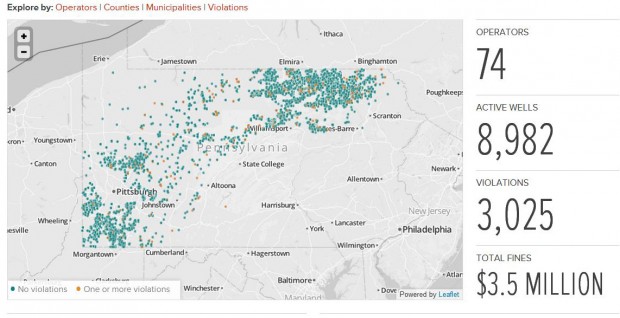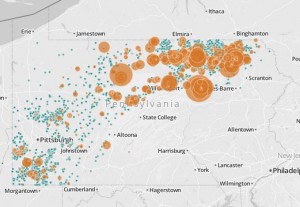StateImpact Pennsylvania’s Shale Play App Tracks Every Marcellus Well
-
Scott Detrow
The number of Marcellus Shale wells featured in StateImpact Pennsylvania’s Shale Play app keeps increasing – though at a slower rate than before.
There are currently 8,982 wells in Pennsylvania – about 2,800 of which are actively producing natural gas. The number in the Department of Environmental Protection’s most recent production report, which covers the first six months of 2012, is about nine percent more than the number of drilled wells from July to December 2011. The most recent total is 18 percent higher than the amount of wells in place during the first six months of last year.
You can view every single well – and find out which company owns it, whether or not it’s incurred any violations, and how many other extraction sites are located in its municipality or county – on the app. The interactive map allows users to search for wells by company or location, track which violations are happening where, and read articles we’ve written about drilling near the site’s location.
For the third reporting period in a row, Bradford County hosts the most drilled wells.
(An important reminder: drilled wells are different than actively producing wells. Our app initially only tracked wells that were turning out natural gas, but we began displaying all wells in June, in order to provide a more accurate portrait of drilling activity.)
Bradford’s rate of growth provides a window into natural gas drilling’s production cycles: the number of drilled wells has only increased by a small margin – 7.6 percent – compared to a year ago. At the same time, though, the amount of gas-generating wells has shot up by more than 100 percent. Bradford was at the forefront of Pennsylvania’s drilling boom, and instead of drilling more holes in the ground, the companies that are active there are focusing on extracting gas from the sites they have already developed.
Due largely to its activity in Bradford County, Chesapeake Energy was the most productive driller during the January-June reporting period. The company extracted 189 million mcf of natural gas. Cabot came in second with 107 million mcf – that’s despite the fact the company has only drilled around 300 wells.
You can track all these companies wells at their respective pages within the Shale Play app.


















